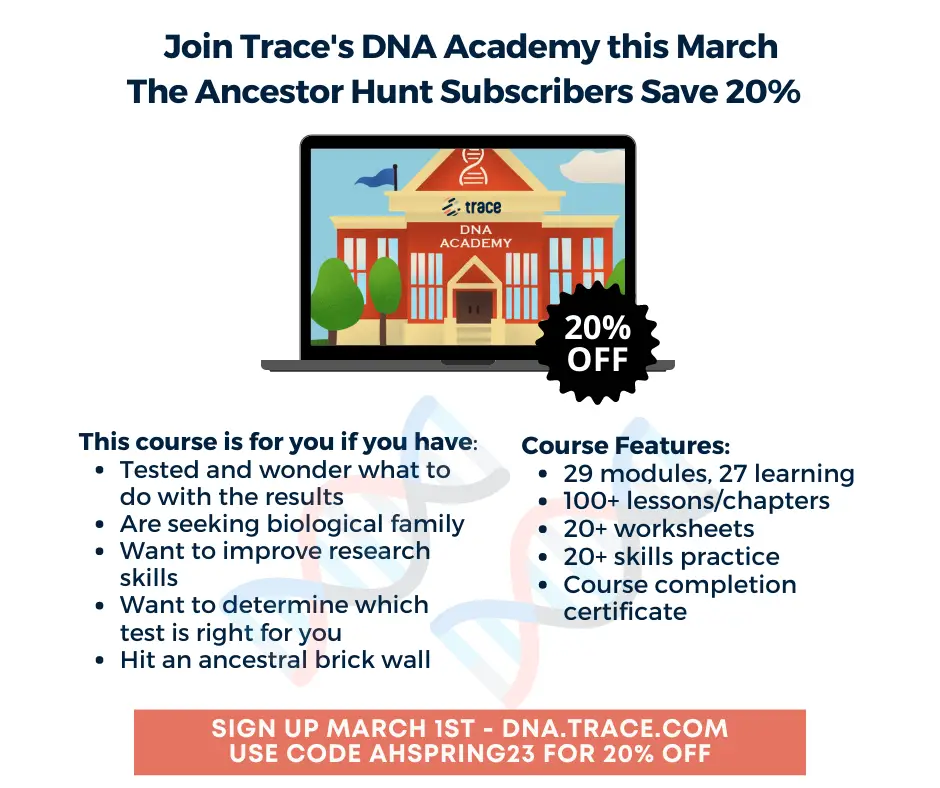
This is a guest article from Trace with some introductory material regarding DNA and Genealogy. They are offering a 20% discount for The Ancestor Hunt subscribers for an outstanding detailed webinar training course all about DNA and Genealogy. Just click on THIS LINK and enter the Coupon Code: AHSPRING23. The coupon will be valid 3/1 – 3/20 and you must use the code to get the discount.
DNA testing has become a powerful tool in genealogy research. It offers a way for people to learn about their ancestry and family history, connecting them with their relatives, both known and unknown, across the world.
Genealogy has been a popular hobby for many years, but it has become increasingly accessible in recent years due to advances in technology. One of the most significant developments has been the use of DNA testing for genealogy purposes. That being said, it isn’t as if you provide a DNA sample and all of those brick walls simply melt away. It is imperative to understand how DNA is inherited and to interpret the test results so that the genetic data can be combined with traditional genealogy to identify unknown biological family members or to extend your family tree for additional generations.
DNA inheritance is the transmission of genetic material from parents to offspring. The genetic material is encoded in the DNA molecule and contains the instructions for the development and functioning of living organisms. DNA inheritance is a complex process that determines the traits and characteristics of offspring, including physical appearance, health, and behavior.
One important aspect of DNA inheritance is the process of recombination, which occurs during the formation of sperm and eggs in sexually reproducing organisms. Recombination shuffles the genetic material from each parent, creating a unique combination of genes in each offspring.
There are several types of DNA that can be inherited, each with its own unique characteristics and modes of transmission.
Autosomal DNA
Autosomal DNA is located on the 22 pairs of autosomes and is responsible for the majority of traits and characteristics in an individual. Autosomal DNA is inherited equally from both parents, with each parent contributing 50% of their autosomal DNA to their offspring. During recombination, pieces of DNA from both parents are shuffled and reassembled to create a unique combination of genes in the offspring.
Mitochondrial DNA
Mitochondrial DNA is located outside the nucleus of a cell in the mitochondria and is responsible for producing energy for the cell. Unlike autosomal DNA, mitochondrial DNA is only inherited from the mother and does not undergo recombination. As a result, all of an individual’s mitochondrial DNA is identical to that of their mother.
Y-Chromosomal DNA
Y-chromosomal DNA is located on the Y chromosome and is only found in males. Like mitochondrial DNA, Y-chromosomal DNA is only inherited from the father and does not undergo recombination. As a result, all of a male’s Y-chromosomal DNA is identical to that of his father.
X-DNA
X-DNA is located on the X chromosome and is found in both males and females. In females, who have two X chromosomes, one X chromosome is randomly inactivated in each cell, resulting in a mosaic of cells with different X chromosomes. In males, who have only one X chromosome, it is the only X chromosome present in their cells. X-DNA is inherited from both parents, with each parent contributing 50% of their X-DNA to their offspring. During recombination, pieces of X-DNA from both parents are shuffled and reassembled to create a unique combination of genes in the offspring.
DNA inheritance is a complex process that plays a critical role in determining the traits and characteristics of offspring. Understanding the different types of DNA and how they are inherited is essential for applying DNA test results in genealogical research.
The DNA Academy is a comprehensive genetic genealogy course where you will learn multiple techniques for demystifying and organizing your research, introducing you to essential tools and tried-and-true methods, while giving you the key skills and confidence to identify biological relations and leap over brick walls. The course is written sequentially so that you begin with the basics of DNA and build to the application of complex research methodologies as you analyze your own DNA or the DNA of others. This means that anyone from a novice to an expert can benefit from this course. It was written by professional genetic genealogists that work on the toughest genetic brick walls every week.
Again, they are offering a 20% discount for The Ancestor Hunt subscribers to take the webinar training course mentioned above about DNA and Genealogy. Just click on THIS LINK and enter the Coupon Code: AHSPRING23. The coupon will be valid 3/1 – 3/20 and you must use the code to get the discount.